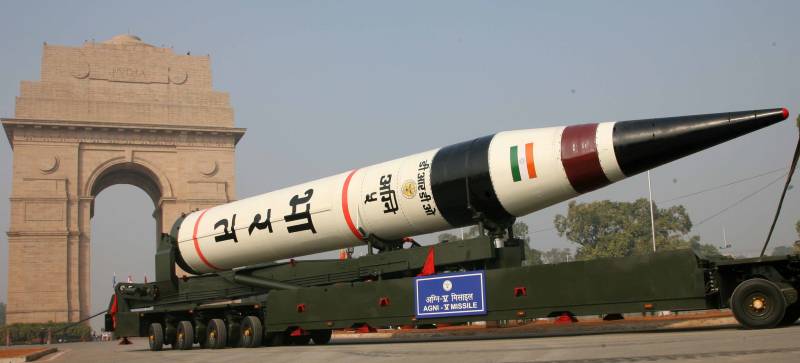The strategic landscape of China, India and Pakistan contours the regional environment because three states share commonalities about historical conflicts, geography and power acquisition. In the South Asian region, the arms race is proportional to the nuclear developments of India. In order to achieve significant superiority over Pakistan and satisfactory status quo with China, India has recently augmented its nuclear and missile program more speedily. Several tests conducted last year by India enhanced the sophistication of its nuclear program and upgraded sea based deterrence. Meanwhile, the recent successful test of Indian Intercontinental Ballistic Missile (ICBM) has embarked a new debate on missile proliferation in South Asia and its impact since the missile has been termed as ‘game changer’ and ‘giant leap’ in country’s strategic calculus.
The final testing of Agni-V ranks India among exclusive states possessing ICBMs. The significant and noteworthy aspect of this development is the incorporation of new technologies in the Agni V missile. The induction of these technologies hints towards future trends, strategies and aspirations. More importantly, the provided canister based launch system would support the storage of missile until the desired launching time. The mated form of warhead and missile would enable the operational flexibility by making the missile preparation/deployment time shorter. It eases the reloading and increases the readiness. Second, this canisterized version from a road mobile launcher would enable the flexibility of launching the missile from anywhere in the country and make the missile highly mobile. A significant technique to ensure safety and reduce the vulnerability of nuclear assets on land is to make them mobile. The frequent mobility of missiles declines the adversary’s capability to continuously monitor and track them with the aim to hit accurately. Moreover, if decoys were also to be placed with real missiles, it would further complicate hitting the opponent’s real missiles. Third, Agni-V is solid fuel propelled missile that offers longer storage life, as compared to liquid fuelled missile which offers less shelf life and demands longer time before preparation. Thus solid fueled missile reduces preparation time, increase accuracy and improve readiness level. Fourth, the test launch of missile in a depressed trajectory would provide the ability to counter ballistic missile defense (BMD). The BMD system consists of sensors to detect and track the missile/warhead and a guided missile, called interceptor, to intercept and destroy the incoming enemy ballistic missiles by using the “hit-to-kill,” direct impact technologies. However, in depressed launch, the angle and less flight time does not provide enough reaction time to BMD to track and hit the target. Fifth, Agni-V is also significant for India’s weapons capability in space. In the words of DRDO Chief VK Saraswat, “Agni V's launch has opened a new era. Apart from adding a new dimension to our strategic defence, it has ushered in fantastic opportunities in building anti-satellite (ASAT) weapons and launching mini/micro satellites on demand”. Sixth, in future, Agni-V is expected to be incorporated with MIRV technology. The coupling of nuclear capable ballistic missile with MIRVs looks more dominant posture for minimum deterrent. Moreover, since neither China nor Pakistan possesses BMD, this technology also signifies Indian ambitions beyond these two states. The range of missile brings a major portion of Asia and Europe (reportedly includes Moscow and Tehran) within its sweep. Accordingly, this submarine launched ballistic missile revolves around a nuclear triad of land, air and sea-based capability.
Consequently, the way India is lately vehemently pursuing its ambition to build long range power projection capabilities, the trend hints to operational deployment of nuclear armed ballistic missiles of different ranges against its adversaries, that certainly includes its two nuclear neighboring states.
Pragmatically, India’s existing strategic threat scenario does not necessitate a missile with range more than 5,000 km. However, it has been reported by Indian officials that after concluding Agni-V flight testing, India will push the development programme of Agni-VI while the capabilities and specifications of missile has already been decided. The question arises that at whom these extended ranges of missiles will be aimed. Although there was no unpleasant reaction from the international community especially from Western state, the Chinese reference about India breaking the UN limits on nuclear arms and long-range missile is significant as far as the global arms control measures are concerned. Chinese stance is that India’s growing role as a non-NPT state is changing the geopolitics of Asia-Pacific region.
Consequently, it is argued by many analysts that India is moving from its minimal deterrent posture to higher state of readiness and war-fighting capabilities. It also underestimates the widely recognized statement that India has a centralized command and control system. The question arises about deploying canisterized missiles under centralized command.
India might be developing most of its capabilities to counter China, yet a variety of capabilities can allow India in future to adopt an aggressive and escalation strategy towards Pakistan. India by developing these sophisticated capabilities is increasing instability in the region, since it would pressurize the neighboring nuclear states to improve the readiness of its weaponry that ultimately would increase missile proliferation and intensify the risk of escalation.






